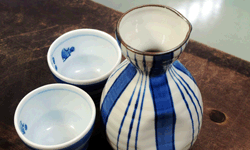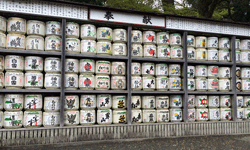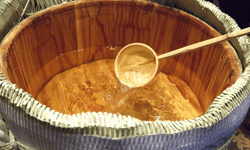


【Outline of Japanese Sake】
Japanese Sake is a rice wine made by fermenting rice that has been polished to remove the outer layers of each grain exposing the starchy core. It has a distinctive aroma and can be served hot or cold, or even just in room temperature.
The alcohol content ranges from 15 to 20%.
It has a long history, almost from the mythology world. Because rice has been a staple food in Japan and made almost throughout Japan, each place has its own local Sake taste.
It is said that good rice and water are indispensable for making good Japanese Sake, but because of wide-spreading producers, we cannot just decide the best Sake by the rice and water, but with their special local producing method.
Each prefecture has its own Sake group, which makes Japan Sake and Shochu Makers Association. You can learn a lot about
Sake by the website. As wine makes the taste of cheese or any other western food better, so does Japanese Sake the taste of typical Japanese food such as Sushi or Sashimi. Sake also go well with western food too. When drinking
Sake, we usually use a small cup called “Ochoko” and a bottle called “Tokkuri”. You can also enjoy “Ochoko” and “Tokkuri” as there are a variety of materials such as pottery, porcelain or glass and shapes such as round, triangle
or cocoon shapes.
Depending on how much percentage of the rice polishing and whether or not alcohol is added, Sake classification differs such as Dai-ginjo, Ginjyo or Junmai Dai-ginjo or Junmai Ginjo. If you like to enjoy the taste of rice, choose “Junmai”.
Until the end of Samurai period, the tax was basically paid by rice in Japan. The head of
farmers collected the rice as the tax from farmer and they sometimes kept the rice for emergency. After some years, such old rice could not be eaten and then used to make Sake by the head. Therefore, it looks like there were many
Sake breweries originated from the head of farmers and having long history from Edo or older history.
People also sometimes donate Sake to shrines and temples. You can see many Sake barrel in a big Shrine which were
donated by each Sake breweries.
Not just drinking Sake, but observing how to make Sake and to taste the Sake of each brewery would be fun to experience.